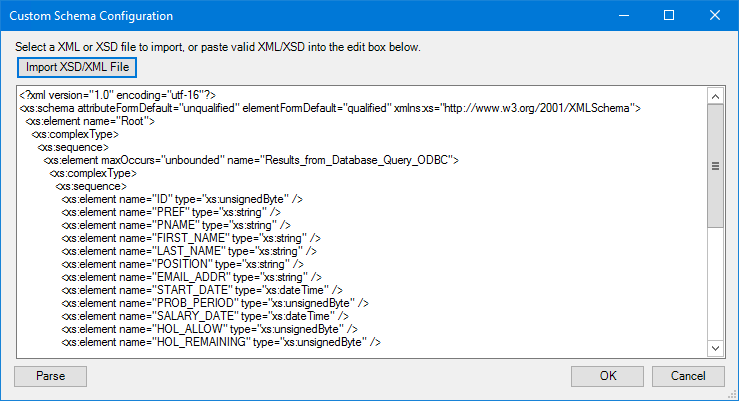- What is the Microsoft Exchange Tool?
- White Paper - Microsoft Exchange Tool Pack 4.4
- Microsoft Exchange Tool Architecture
- Microsoft Exchange Tool: Working with Other Tools
- About the Microsoft Exchange Event Agent
- About the Microsoft Exchange Connector Agent
- Adding a Microsoft Exchange Connection
- Microsoft Exchange Tool: Step Configuration
What is the Microsoft Exchange Tool?
Use components in the Microsoft Exchange Tool Pack to send and retrieve data from Microsoft Exchange, including:
- Email messages
- Calendar meetings and appointments
- Contacts
- Task items
You can also use the Microsoft Exchange tool pack to create user-defined folder structures.
All this allows for data to be synchronised between Exchange and third-party systems that it does not normally connect with.
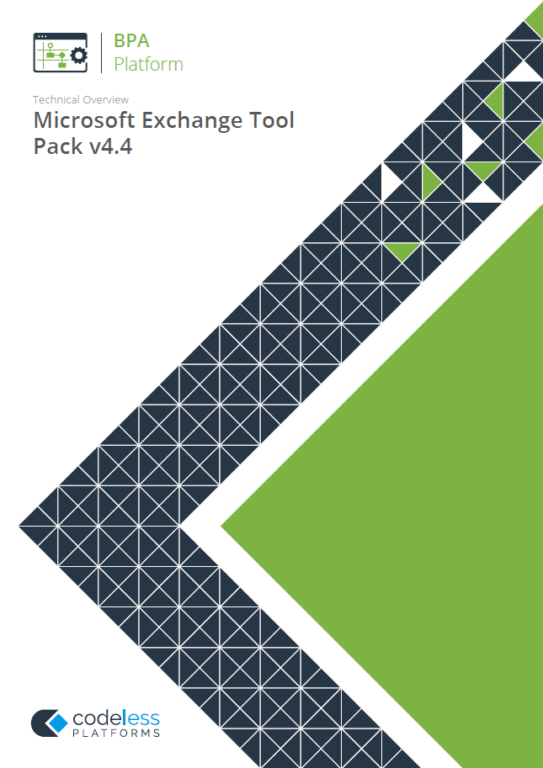
White Paper - Microsoft Exchange Tool Pack 4.4
The Microsoft Exchange Tool Pack
The Microsoft Exchange integration tool pack consists of:
- Microsoft Exchange Event Agent — This Agent subscribes to events occurring in Exchange. When an event occurs, the Event Agent is notified allowing BPA Platform to act accordingly. The Event Agent can be installed on any computer that has access to both the BPA Platform server and Exchange, local to the BPA Platform server, or if available, on the on-premise server hosting Exchange.
- Microsoft Exchange Connector Agent — This Agent communicates directly with the Exchange Web Service (EWS). It can be installed on any computer that has access to both the BPA Platform server and Exchange, local to the BPA Platform server, or if available, on the on-premise server hosting Exchange.
- Microsoft Exchange Connector — The Connector communicates directly with the Connector Agent instead of directly interacting with Exchange. It must be installed on the BPA Platform server and any remote BPA Platform client computers which run Microsoft Exchange Connector tasks.
Microsoft Exchange Tool System Requirements
The following prerequisite software must be in place before installing the Microsoft Exchange Tool Pack:
Minimum BPA Platform Software
The Microsoft Exchange Tool Pack requires BPA Platform (formerly known as “TaskCentre”) version 2020 or above.
Minimum Microsoft Exchange Version
This tool pack is compatible with:
- Exchange 2013 — on-premise or hosted (both local and remote are supported)
- Exchange 2016 — on-premise or hosted (both local and remote are supported)
- Exchange 2019 — on-premise or hosted (both local and remote are supported)
- Exchange 365 / Exchange Online — referred to as Exchange 365 in this document
Microsoft Exchange Tool Architecture
The diagram below provides a high-level system architecture overview of the Microsoft Exchange Tool Pack with BPA Platform and the EWS.
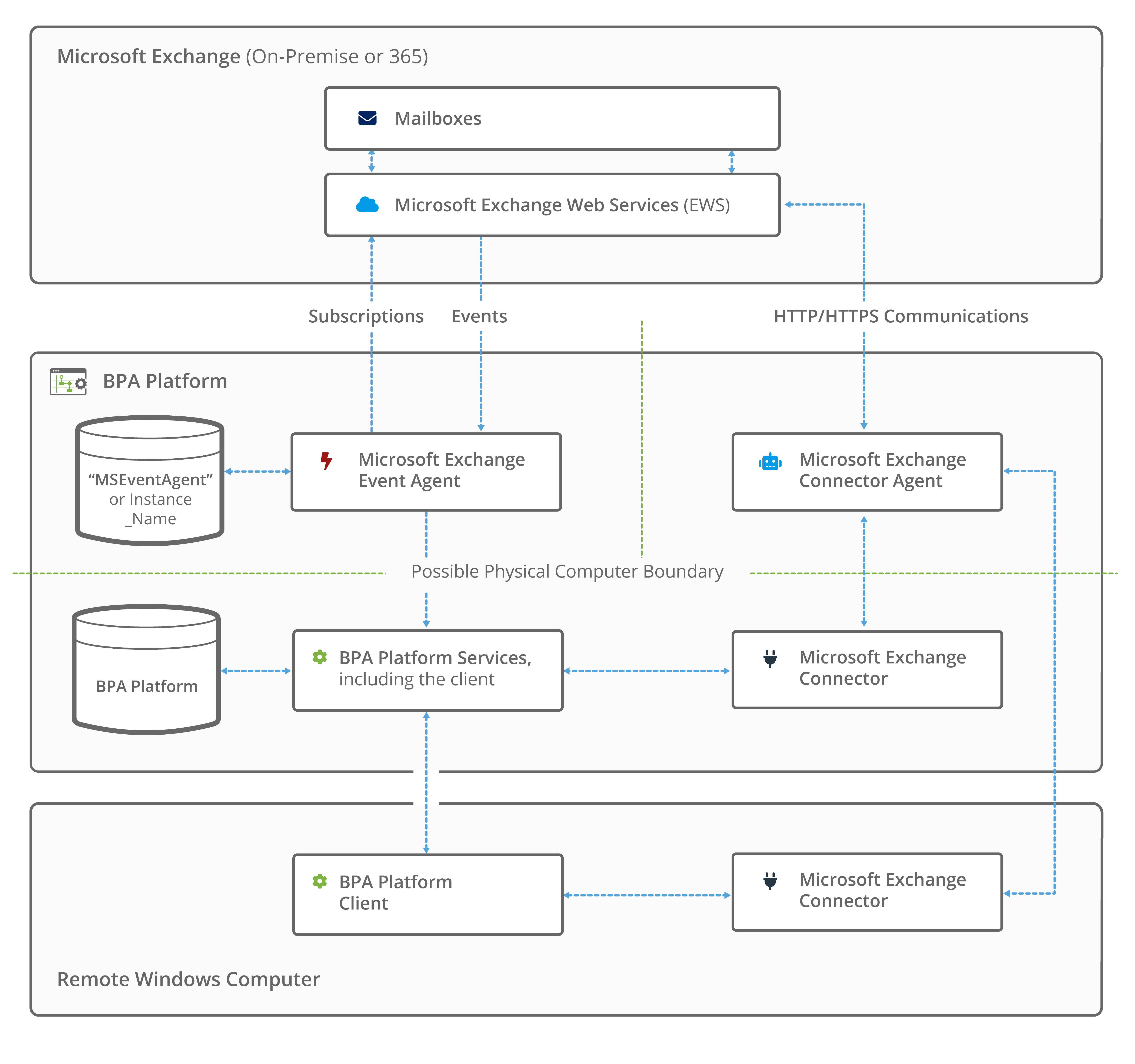
Whether Exchange is locally or remotely hosted, or supplied as part of Office 365, the connection between Exchange and BPA Platform is via the EWS.
The Microsoft Exchange Event Agent must be registered with the BPA Platform server. The only other communication the Event Agent has with BPA Platform is to log error messages in the Event Log (Tasks toolbar > Event Log) — hence the one-way arrow in the above diagram; all configuration for the Event Agent must be done through the Microsoft Exchange Event Agent Configuration wizard. To access the events in the Event Agent’s database, you must use the Database Query (ODBC), Database Query (OLEDB), or Microsoft SQL Server Trigger tools, refer to the product help. The Event Agent requires access to a SQL Server instance to store and manage the mailbox events — this can be local to the Event Agent installation or on a remote computer that the Event Agent can access. Should your organisation make use of multiple Exchange instances, for example, a local on premise installation as well as using Exchange 365, only a single installation of the Event Agent is required but additional Event Agent services must be configured — see About the Microsoft Exchange Event Agent Instance Manager.
The Microsoft Exchange Connector Agent is the Connector’s interface to the EWS. It only requires access to Exchange and the computer hosting the Microsoft Exchange Connector (if not installed locally).
Both Agents can be installed local to the BPA Platform server or together on a remote Windows computer that has access to Exchange, BPA Platform, and SQL Server. Separate remote installation of the Agents is also supported so long as access to necessary components is available.
The Microsoft Exchange Connector must be installed on the BPA Platform server and any remote installations of the BPA Platform client where Microsoft Exchange Connector tasks are required.
Microsoft Exchange Tool: Working with Other Tools
The Microsoft Exchange Connector can directly interact with the following tools:
Consuming from Other Tools
The Microsoft Exchange Connector can consume output from the following tools:
| Icon | Tool Name | Tool Category |
|---|---|---|
| Import XML Document | Input | |
| Retrieve Text Message | Input | |
| Convert Recordset to XML | Format | |
| Transform Data | Format | |
| Call Task Tool | Execute | |
| Applications Platform Connector | Data Connectors | |
| Microsoft Exchange Connector | Data Connectors |
In addition, the Microsoft Exchange Connector can consume the output from other Data Connector tools that provide connectivity to an external application, such as an ERP or CRM system.
Objects Consumed
The Microsoft Exchange Connector consumes the following objects exposed by other steps:
- XML — XML data from any BPA Platform tool capable of exposing such data (see above)
Exposing to Other Tools
The following tools can directly consume output form the Microsoft Exchange Connector:
| Icon | Tool Name | Tool Category |
|---|---|---|
| Retrieve Text Message | Input | |
| Convert XML to Recordset | Format | |
| Run Microsoft Reporting Services | Format | |
| Transform Data | Format | |
| Save File | Output | |
| Call Task | Execute | |
| Applications Platform Connector | Data Connectors | |
| Web Service Connector | Data Connectors | |
| Microsoft Exchange Connector | Data Connectors |
In addition, other Data Connector tools that provide connectivity to an external application, such as an ERP or CRM system, can also consume the output from the Microsoft Exchange Connector.
Objects Exposed
The Microsoft Exchange Connector tool outputs the following objects which can be consumed by other tools:
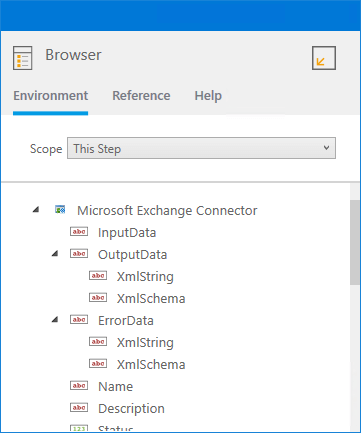
- InputData — This document contains the input XML received by the Microsoft Exchange Connector tool. It is only available if a task step has been selected as the Data Source (see About the General Tab).
- OutputData — The OutputData object contains two sub-objects:
- XmlString — This is the XML document produced by the tool, containing data returned from Exchange for all operations. Also included are the key fields for the mapped elements affected by the used operation and a
SupplementaryReferencefield for task auditing purposes. The mapped fields in the Mapping tab (see About the Mapping Tab) define the structure of this XML document. - XmlSchema — This contains the output schema in XSD format.
- XmlString — This is the XML document produced by the tool, containing data returned from Exchange for all operations. Also included are the key fields for the mapped elements affected by the used operation and a
- ErrorData — The ErrorData object also contains two sub-objects:
- XmlString — This contains any error data reported by Exchange
<ErrorData>
<Exchange_ObjectItem />— The mapped object, for example, ContactItem
<mapped_fields />— All the fields that were mapped with their values that were sent to Exchange, plus all data contained in SupplementaryReference
<ResponseCode />— The error code received back from Exchange
<ErrorDetails />— The error text received back from Exchange
</ErrorData>
For more information about the errors received, see Error Handling. - XmlSchema — This contains the output schema in XSD format.
- XmlString — This contains any error data reported by Exchange
- Step Properties — Standard step properties are also available allowing you to use statistical data of the Microsoft Exchange Connector step.
Where Can the XML Output be Used?
The incoming XML is translated into the XML format for the object and operation selected in the configuration. The data for the linked fields is brought across into the output XML — only those fields that are linked are brought across. The XML is passed to the Connector, which then:
- Processes the data
- Performs the operation requested
- Receives an XML document containing the response
Both the OutputData and ErrorData documents can be directly used by succeeding task steps that can consume XML data, as part of an application integration or synchronisation process. To use the documents in a non-XML consuming tool, use a Convert XML to Recordset or Transform Data step first to create a recordset copy of the XML data.
The XML documents are also available as consumable objects from the Task Browser (XmlString). When used in a task step, such as Format as Text or Save File, this exposes the actual XML string.
Error Handling
Errors are written to the BPA Platform Event Log (Tasks toolbar > Event Log). You define how errors are handled in the Options tab of the tool (see About the Options Tab).
Reasons for the errors could include:
- Web service connection errors
- User privilege errors
- Errors, messages, and warnings from the Microsoft Exchange API
- Any reported task runtime errors, including Connector or Event Agent errors, such as, loss of connection
About the Microsoft Exchange Event Agent
Use the Microsoft Exchange Event Agent to create tasks based on activity in specified mailboxes in Exchange. This activity includes:
- An object or folder being copied in the mailbox
- An object or folder being created in the mailbox
- An object or folder being deleted in the mailbox
- An object or folder being modified in the mailbox
- An object or folder being moved in the mailbox
Where object relates to the part of the mailbox being monitored, for example, the inbox or calendar, and folder is an Exchange folder ID number for a custom mailbox folder.
When installed, the Microsoft Exchange Event Agent creates its own SQL Server database (named MSEventAgent by default, unless additional instances are created) where it records events that Exchange has notified it about. Stored procedures are available that allow you to:
- Specify the mailbox to monitor (
Subscribe) - Update the processed flag for record (
UpdateNotifications) - Remove processed records from the database (
RemoveProcessedRows) - No longer monitor the mailbox (
Unsubscribe)
You can configure the Event Agent to monitor more than one instance of Exchange without the need to install multiple Event Agents. For a detailed description of how to do this, see About the Microsoft Exchange Event Agent Instance Manager.
For a detailed description of the stored procedures and runtime processing for the Microsoft Exchange Event Agent, refer to the Microsoft Exchange Tool Pack Data Dictionary.
Using the Microsoft Exchange Event Agent Configuration
Immediately after installation, the Microsoft Exchange Event Agent Configuration wizard is launched. (For a detailed description of how to install the Microsoft Exchange Event Agent, refer to the Microsoft Exchange Tool Pack Quick Start Guide.
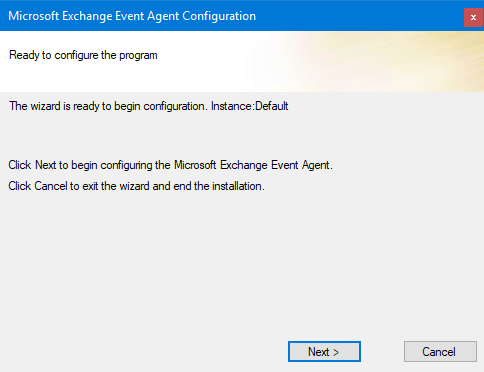
This wizard steps through creating the connection from the Microsoft Exchange Event Agent to the Exchange Web Service (EWS) and the BPA Platform server.
Adding the SQL Server Connection
The Microsoft Exchange Event Agent requires access to an SQL Server instance to store event notifications from Exchange.
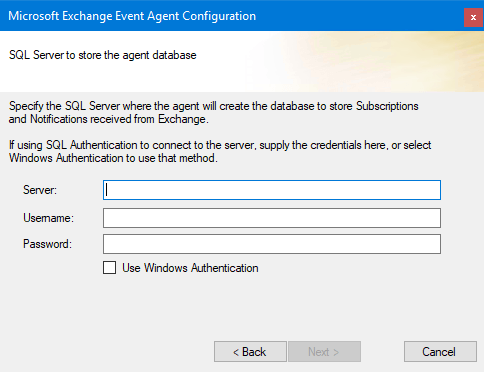
Adding the Windows Service User Account
The Microsoft Exchange Event Agent, as a Windows service, requires a Windows user account to run under. This user account must have permissions to add, update, and remove records from the Event Agent database.
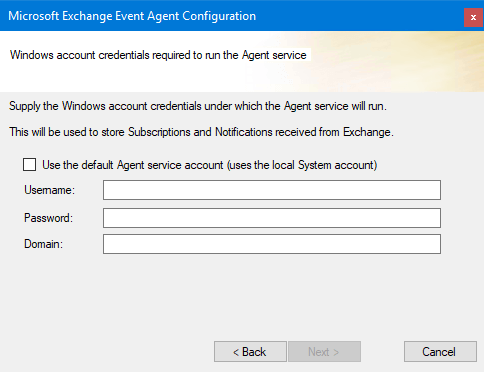
Typically, the Windows Local System account which the Event Agent services runs as has the relevant permissions to read and write to the Event Agent database (Use the default Agent service account).
Adding the Push Endpoint
When Exchange has accepted the subscription requests, it pushes all event notifications to a nominated endpoint.
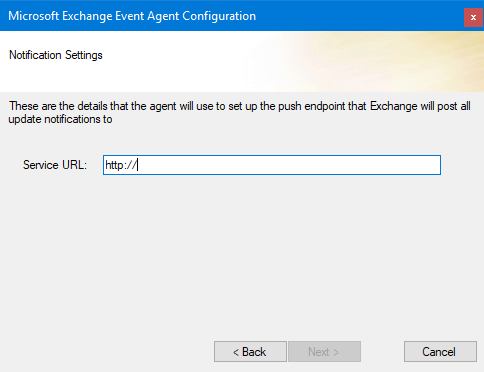
Adding the Exchange Web Service Connection
You must supply the Exchange server details this Microsoft Exchange Event Agent connects to.
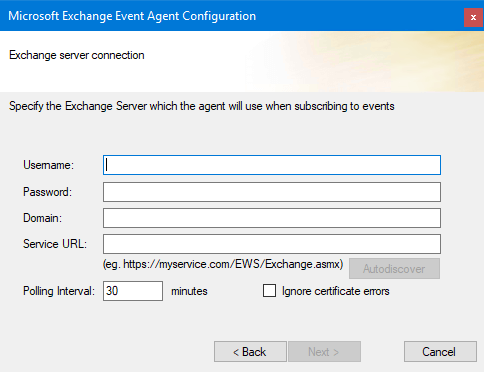
Adding the BPA Platform Connection
The final stage of the Microsoft Exchange Event Agent Configuration wizard is to register the Event Agent with the BPA Platform server.
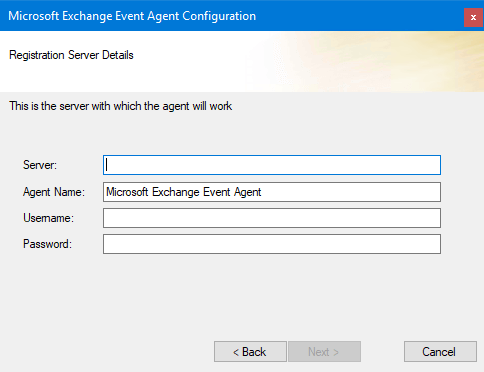
About the Microsoft Exchange Event Agent Instance Manager
If you previously cancelled out of the Microsoft Exchange Event Agent Configuration wizard without completing the configuration, you can re-launch it from the Microsoft Exchange Event Agent Instance Manager. This is located in the BPA Platform menu group in the Windows Start menu.
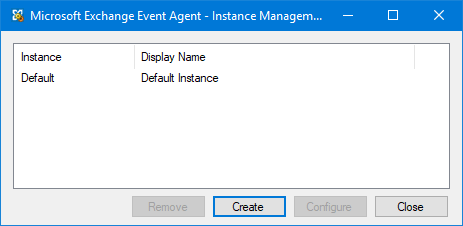
Unlike the Connector Agent where it can only connect to a single Exchange instance, you can also have the same Event Agent subscribe to events from different Exchange instances — for example, if your organisation makes use of an on-premise Exchange server as well as Exchange 365.
The Default Instance shown above is the one you create immediately after the Event Agent has finished installing.
To create additional instances, click Create.
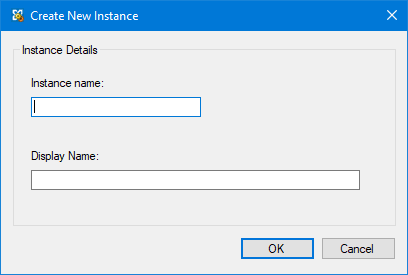
Enter a unique and meaningful Instance Name; note that this is the name given to the database used to store Exchange events and so is used to form the Computer Name when the Event Agent is registered with the BPA Platform server:
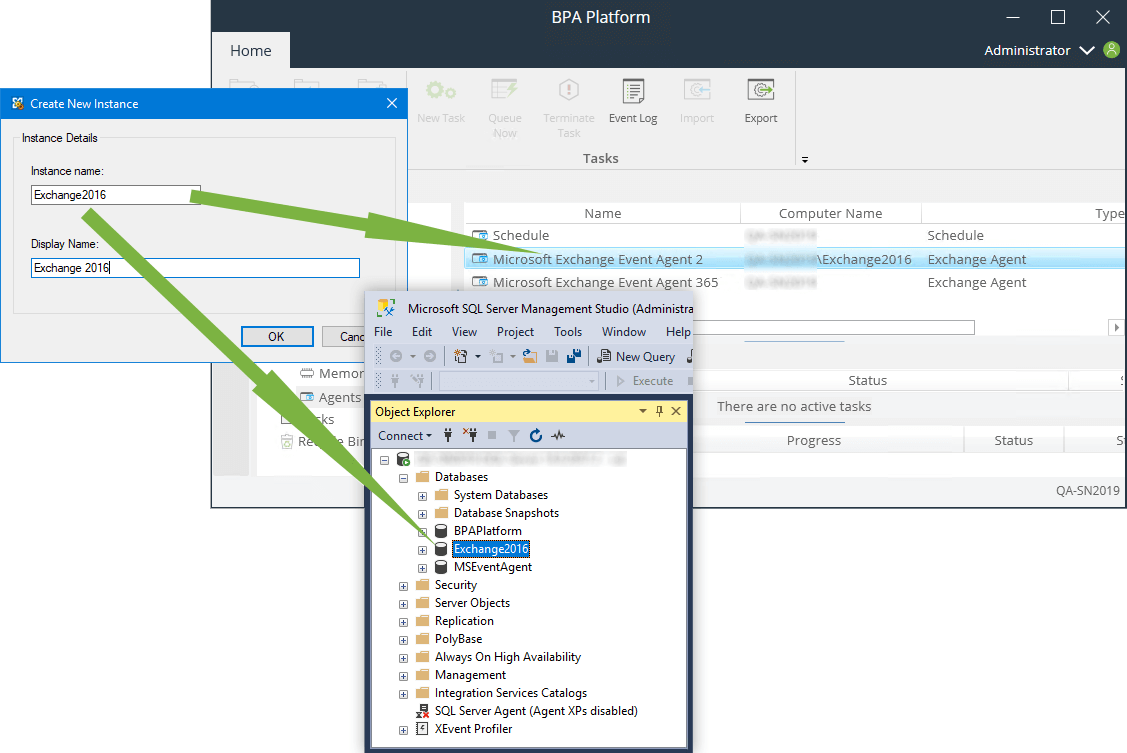
The Microsoft Exchange Event Agent Configuration wizard is launched after this window — see Using the Microsoft Exchange Event Agent Configuration.
Use Configure to change any of the Event Agent connection parameters — note that you cannot change the Instance name once the database has been created.
About the Microsoft Exchange Connector Agent
To communicate with the Microsoft Exchange Web Service (EWS), you must install the Microsoft Exchange Connector Agent. This acts as a “go-between”, updating and retrieving data for use in Microsoft Exchange Connector tasks. The Agent can be installed local to the BPA Platform server, on a remote computer that has access to both the BPA Platform server and your Exchange instance, or if available, local to the on-premise Exchange server.
Adding a Microsoft Exchange Connection
The global configuration for the Microsoft Exchange Connector is used to create connections to the Microsoft Exchange Connector Agent and the Exchange web service.
You open this interface from the resources tree — expand System > Tools > Data Connectors and double-click Microsoft Exchange Connector in the items list.
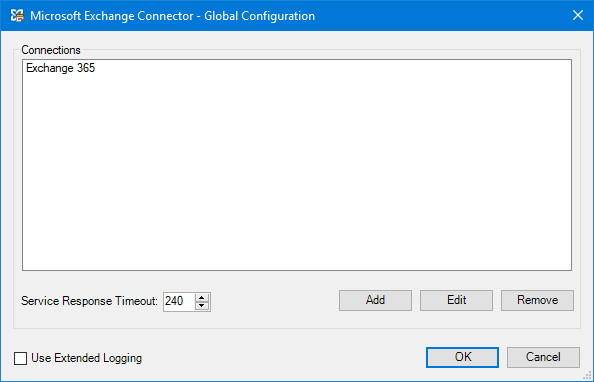
When a connection is created, the available objects and fields of your Exchange installation are retrieved.
Click Add to create a connection to Exchange.
Setting the Time Out
You can control how long the Microsoft Exchange Connector waits for a response from Exchange before setting the connection to an “unconnected” status.
The default time out is 240 seconds. Typically, this a sufficient length of time required for a response from the Exchange Web Service, but you can adjust the Service Response Timeout parameter to suit your organisational needs.
Using Extended Logging
Selecting this option exposes the full XML parsed between the Microsoft Exchange Connector and Microsoft Exchange.
Without extended logging, the Event Log only contains start and end of transaction messages, plus any error messages encountered at runtime.
You can view the extended log in the BPA Platform Event Log (Tasks toolbar > Event Log).
About the Agent Connection Tab
Use this tab to configure the connection to the Microsoft Exchange Connector Agent (the Microsoft Exchange Event Agent is configured separately).
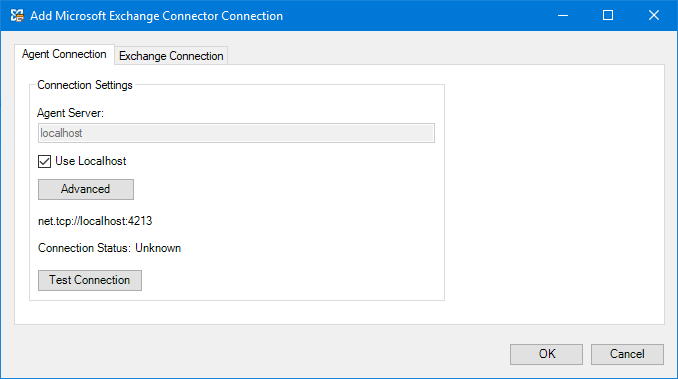
Enter the Agent Server (hostname or IP address) hosting the Connector Agent installation. If it is installed local to the BPA Platform server, click Use Localhost instead.
By default, the Connector Agent to Connector communication is over port 4213. If the Connector Agent has been configured to use a different port, click Advanced and select Set Custom Port Number. Enter the new port in the box provided.
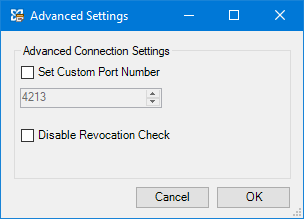
If using self-signed SSL certificates to validate the connection between the Connector Agent and the EWS, you can select Disable Revocation Check to prevent checking the certificate against the Certificate Authority’s revocation list.
Use Test Connection to ensure the Agent can be reached successfully.
About the Exchange Connection Tab
Use the Exchange Connection tab to configure how the Microsoft Exchange Connector Agent connects to the Exchange Web Service.
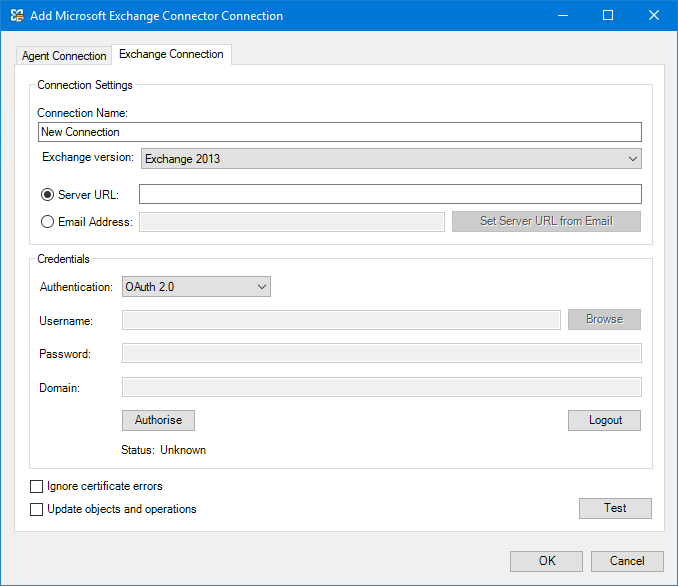
Configure a meaningful Connection Name for this Agent connection; this is the Connection name used when creating Microsoft Exchange Connector task steps. From the Exchange version drop-down, choose the relevant version you are running. If connecting to Office 365, select Exchange Online.
If the URL to the Exchange service, exchange.asmx, is known, enter it into Server URL, using the following format: https://hostname_or_ip_address_or_url/ews/exchange.asmx where hostname_or_ip_address_or_url is the hostname or IP address of the on-premise Exchange server, or the URL of the Exchange 365 instance.
If the URL is not known, it can be determined from a valid email address. To do this, select Email Address and enter the assigned email into the box provided, enter the OAUTH2.0 account Credentials in the pane below, and click Set Server URL from Email.
Whether the Server URL is known or you’re determining the URL from an Email Address, the Agent requires Exchange credentials. Choose the relevant Authentication method from the drop-down:
- OAUTH2.0 — If connecting to Exchange Online, use this authentication type. Click Authorise and enter the
account details in the Microsoft Authorisation Console. - Transparent Windows — Use the credentials for the currently logged in Windows account.
To use this option, the Windows account must also:- Have permission access the Exchange server
- Must be an administrator (granted delegation permissions in Exchange)
If connecting to an on-premise Exchange server, the BPA Platform server must be in the same Active Directory domain.
- Basic — Enter the Username, Password, and (optional) Domain of the Microsoft Exchange Connector Agent’s account. Use Browse to search for the Username in Active Directory.
Processing Certificate Errors
To ignore any untrusted certificate errors that may occur when connecting to Exchange, select Ignore certificate errors. To “self-certify”, leave this option blank and register the Exchange server certificate on the BPA Platform server — for more information, see our knowledge base article, How to register a third party server certificate for use on a BPA Platform server.
Updating Objects and Operations
Enabling Update Objects and Operations allows the Microsoft Exchange schema in BPA Platform to be refreshed every time an update is made in Exchange itself.
Should you also upgrade Exchange to a newer, compatible version, all related schemas within BPA Platform must be refreshed. To do this, select this option and save the changes. You must repeat this for each existing connection you have defined.
Microsoft Exchange Tool: Step Configuration
When creating new tasks, the Microsoft Exchange Connector is located under Data Connectors of the Task Browser.
To add a new Microsoft Exchange Connector step to an existing task, do the following:
From the relevant task, either:
- Click and drag the Microsoft Exchange Connector icon from the Task Browser to the task Design area.
- From the task’s Design tab, right-click on empty space and select New > Data Connectors > Microsoft Exchange Connector.
For a detailed description of how to create new tasks, refer to the product help.
About the General Tab
Use the General tab to choose the BPA Platform data source to be mapped to the Microsoft Exchange objects. The data source must be in XML form. To map BPA Platform recordsets, configure a Convert Recordset to XML or Transform Data step in the task before the Microsoft Exchange Connector step, then select this as Task step (see below).
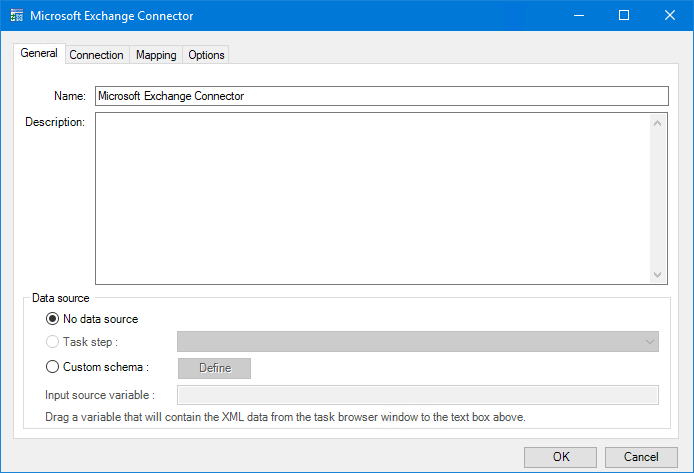
Provide a meaningful Name and Description for this step.
Data source can either be:
- No data source — If you don’t make use of a dedicated XML input source, select this option to use BPA Platform variables in place of the XML objects’ fields. For example, you can extract various bits of information from an email and store them in BPA Platform variables. The variables are then mapped to Microsoft Exchangeoperational objects and fields.
- Task step — The data source can be set to an available BPA Platform XML data source. Only those steps that are capable of natively exposing an XML document at runtime are listed. This may be another Microsoft Exchange Connector step, or a tool such as Convert Recordset to XML or Transform Data.
- Custom schema — An XML schema defines the structure of the parsed XML: what tags are present, and the nesting of the tags. You Define the schema of the XML that is used as the input data source for this step. The Microsoft Exchange Connector tool uses the industry standard XSD format. Any XML processed by this step must conform to this schema else an error will be reported. If the XSD schema is available, either import it into the Custom Schema Configuration (use the Import XSD/XML File button), or copy and paste it into the configuration box.

If the XSD schema is not available, you can import an example of the runtime XML (Import XSD/XML File), or copy and paste it into the configuration box. Use the Parse button to create the schema.- Input source variable — As well as defining the schema, specify the BPA Platform variable that contains the XML data at runtime.
About the Connection Tab
To map task data to Microsoft Exchange, you must specify with Exchange connection to use.
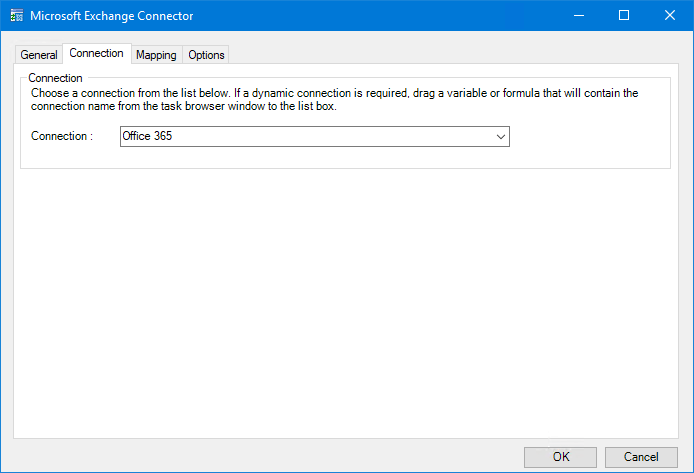
All connections created in global configuration are presented here.
Alternatively, you can use a BPA Platform variable or formula to create a dynamic connection, where the connection used is determined by runtime circumstances. At runtime, the contents of the variable must match the name of one of the global connections — this is case-sensitive. To do this, you must install an Microsoft Exchange Connector Agent for every Exchange server you want to connect to.
About the Mapping Tab
Use the Mapping tab to define links between the data source XML (see About the General Tab) and those required by Exchange. This defines how, at runtime, the incoming XML is to be translated into the XML required for the relevant object and operation.
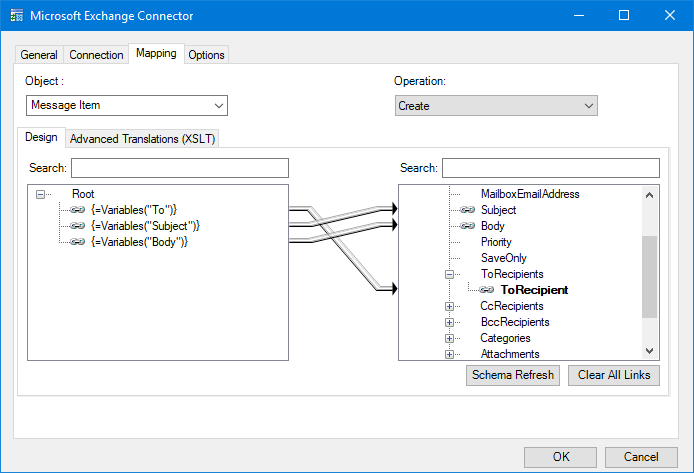
The Object drop-down shows the available Microsoft Exchange objects. The Operations drop-down shows the operations available for the selected Object.
For more information about supported objects and operations, see Supported Objects.
Further down, the left-hand XML tree structure shows those data source fields available for mapping (see About the General Tab). The right-hand XML tree structure displays those input fields for the selected Object and Operation.
Creating Mappings
Create links by dragging and dropping a data source field (left) onto its corresponding Microsoft Exchange Connector input field (right). Only linked fields are used in the output XML.
BPA Platform formulas and variables can be included in the source data even when using a Task step or Custom schema (see About the General Tab) — drag them from the Task Browser to the data source’s XML; these can then be linked to the relevant input fields. BPA Platform recordsets must first be converted to XML using either the Convert Recordset to XML or Transform Data tool before they can be used here.
Each operation has an additional field, SupplementaryReference, which allows for traceability when transferring data from one place to another. When mapped, the data resides locally at runtime. It is added to the output, and creates a record for reference purposes only — you can choose to map any field to SupplementaryReference to assist with checking where the data originated from or at what time the data transfer occurred, for example.
The Microsoft Exchange Connector tool uses eXtensible Stylesheet Language Transformations (XSLT) to translate the received XML. The Advanced Translations (XSLT) tab shows the XSLT generated for the links created for the object and operation. Use Enable Free Type Mode to directly edit the XSLT — this is particularly useful when translating a non-standard requirement.
Refreshing the Exchange Schema
If new fields, objects, and operations have been added to your Exchange instance after this task step was originally created, use Schema Refresh to make the latest API metadata available for use (ensure Update Objects and Operations is selected first in the relevant global connection).
Supported Objects
The Microsoft Exchange Connector makes the following objects and operations available for mapping, with fields that must be mapped highlighted:
| Object | Operations | ||||||
|---|---|---|---|---|---|---|---|
| CREATE | DELETE | FIND | GET | UPDATE | Notes | ||
| Calendar item | Subject Body | Exchange- CalendarId | Search- Field Search- Expression | Exchange- CalendarId | Exchange- CalendarId |
| |
| Contact Item | No mandatory fields for the CREATE operation. | Exchange-ContactId | Search-Field Search-Expression | Exchange- ContactId | Exchange- ContactId | ||
| Task Item | No mandatory fields for the CREATE operation. | Exchange-ContactId | Search-Field Search-Expression | Exchange- ContactId | Exchange- ContactId | ||
| Message item | ToRecipient | Exchange- MessageId | Search- Field Search- Expression | Exchange- MessageId | Exchange- MessageId |
| |
| Folder item | Name | Exchange- FolderId | Search- Field Search- Expression | No mandatory fields for the GET operation. | Exchange- FolderId | ||
For a detailed description of the available fields for each object and operation combination, refer to the Microsoft Exchange Tool Pack Data Dictionary.
About the Options Tab
The Options tab allows you to define how errors in this step are handled at task runtime.
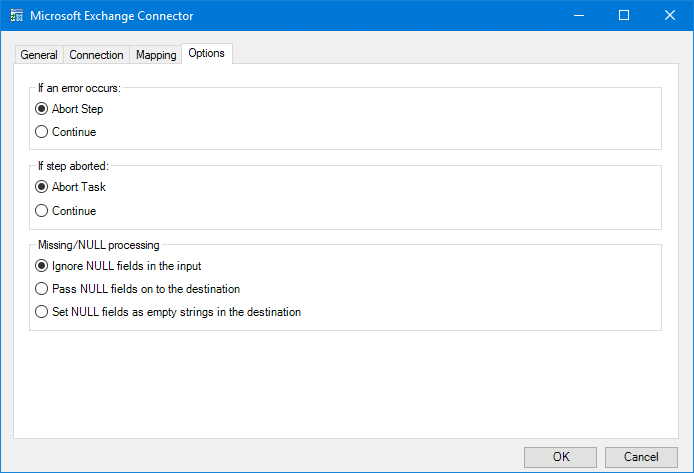
If an error occurs, you can decide whether the step should Continue processing, or terminate the step immediately (Abort Step).
If the step is aborted, you can choose to Continue processing onto the next step in the task, or terminate the whole task immediately (Abort Task). By allowing the task to Continue, you can use the error XML received back in a Save File step for investigation purposes, for example.
Processing Incomplete Inputs
You can also control how the Connector processes missing input or empty input elements for mapped fields — a missing input is where a field is mapped in the Mapping tab (see About the Mapping Tab) but not received in the input (see About the General Tab), whereas an empty element is where <element_name></element_name> or <element/> is received in the input. The following behaviours are available:
- Ignore NULL fields in the input (default selection) — Missing fields or those received without a value are not passed to Exchange even though they are mapped (and therefore required)
- Pass NULL fields on to the destination — This option appends
xsi:nil="true"to the element: <element_name xsi:nil=”true” xmlns:xsi=”http://w3.org/2001/XMLSchema-instance></element_name>
xmlns:xsi="http://w3.org/2001/XMLSchema-instance - Set NULL fields as empty strings in the destination — Missing fields or those received without a value are
passed without values: <element_name></element_name>
